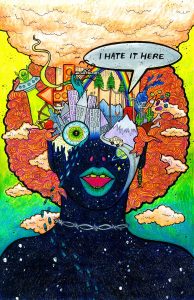
 Somewhat Recommended ** We all hated the year of COVID for many different reasons. Not only did we hate what changed in our personal lives but also what was happening to us as a nation. And yes, we all wanted to cry out, “I’m mad as hell, and I don’t want to take it anymore!” The show “I Hate It Here” is a snapshot of this period in history. It falls into the genre of how well or poorly we coped during the pandemic, but unlike similar productions dealing with this subject matter, there is little, if any, comic relief from the sorrows of the recent past and from those which may have accumulated over the years.
Somewhat Recommended ** We all hated the year of COVID for many different reasons. Not only did we hate what changed in our personal lives but also what was happening to us as a nation. And yes, we all wanted to cry out, “I’m mad as hell, and I don’t want to take it anymore!” The show “I Hate It Here” is a snapshot of this period in history. It falls into the genre of how well or poorly we coped during the pandemic, but unlike similar productions dealing with this subject matter, there is little, if any, comic relief from the sorrows of the recent past and from those which may have accumulated over the years.
Written by African-American playwright Ike Holter and directed by Lili-Anne Brown, “I Hate It Here” emphasizes history, culture, and race via a mix of people from different backgrounds, races, and social classes. More specifically, this 70-minute show consists of twelve separate vignettes, most of which include poignant reflections on racism, the future of our society, and the status of minorities within it during the pandemic and its aftermath. Produced by Chicago’s Goodman Theatre as part of their LIVE series, this presentation combines live action, film roll-ins, and excellent projection design to create a video stream in real time, which can be watched by a virtual audience. Seven actors play multiple parts throughout: Patrick Agada, Jayson Brooks, Sydney Charles, Behzad Dabu, Kirsten Fitzgerald, and Gabriel Ruiz, plus director Brown as Charlotte.
Unfortunately, the mélange of constituent short stories is choppy and uneven and don’t cohere well as a group. The weaker accounts drag down those containing more thoughtful revelations. For example, one of the more interesting segments features Lisa, a white woman, and Thomas, a black man, who are strangers who converse at a wedding. We subsequently learn that Lisa, a nurse, did not come to Thomas’s aid when he was beaten up on a train for no reason —and that is why he now walks with a cane. The line “You could’ve said ‘stop’” is an excellent one. But so many other scenes are overacted where the characters seem especially boorish, self-centered, and thoughtless that it becomes hard to take their observations as seriously as we could. When every other word is “fuck” or “bitch” (especially during the first half of the show), the issue is not that of coarseness but rather how the audience can best strip away the vulgarity and senselessness so we can understand these characters’ complaints. For example, Martin works at a chicken chain restaurant as an essential worker. His situation seems so ridiculous—and not funny—that I found it very easy to tune out. In fact, at one point during a subsequent vignette, I found myself far more interested in watching the birds outside my window than paying attention to my computer screen.
The main problem with “I Hate It Here”, however, is that we need to we feel more empathy for the characters as a whole. Holter needed to be more judicious in researching and selecting tales to include in his larger story; for as things stand, these twelve segments may not necessarily provide the most impactful examples of what being black might mean in a time of COVID. Allow me to explain further by using a personal example: A good friend of mine told me about her 45-year-old son who had died during the pandemic, most likely from COVID. His girlfriend eventually had to scale the wall surrounding his ample Texas ranch to find him dead; his body lying in a hot tub. But this is Texas, and my friend and her son are black, and she’s convinced that the police would have taken the missing person’s report much more seriously had her son been white. The authorities finally took things seriously enough only after the girlfriend reported the untimely death—and she was white. And they never launched a thorough investigation of the matter. But I digress…. My point here is that rarely in the current show do we witness action needed to match the talk about living in ill-fated circumstances.
Regardless of whether we are a member of the majority or minority population, each of us was affected differently by the COVID-19 crisis, some more profoundly than others; yet we were united in general by this reality. Friends and family members were dying. People were grieving. Racism reared its ugly head with the George Floyd murder. The economy was shut down. People lost their jobs and had to find new—often unsatisfactory ones—as essential workers. Crime was on the rise. We listened to briefings on the status of the pandemic and watched the nightly news together. There was always the fear lurking of possibly getting sick and dying. Each and every one of us gained some new perspective on life and living, whether we were able to express ourselves about what was happening or not. The playwright, however, had the advantage and good fortune to take some of this material and team up with a good director and the Goodman Theatre’s fantastic production design team. Together they dolled up the script and produced this play for a remote audience. The technical crew smoothly integrated the camerawork and audio from the live stage performance with superb projection design and clever film editing. This is quite an accomplishment for which we have to thank video director Christiana Tye, director of photography Gabe Hatfield, and projection designer Paul Deziel, as well as sound designer Mikhail Fiksel, lighting designer Jason Lynch, and technical director Bob Ness. The open captioning unfortunately followed the action when it should have been simultaneous.
Although the performance got better as time progressed, it was never good enough to overcome severe deficiencies in the script. The show is too much of a disjointed hodgepodge. What vaguely binds everything together is the title “I Hate It Here”—and the theme song by the same name and the accompanying dance number, both of which are quite good. Sadly, since a substantial portion of the dialogue is foul, insulting, and crude, this diverts us from examining deeper issues having to do with racial inequity. Some may see this show as being a call-to-arms, but others, like myself, will find it unsatisfying. I suggest that the audience focus on several really good sound bytes plus how well everything has been constructed technically. All of us certainly hated the last year and everything associated with it. I personally lost one of my favorite cousins during this time as well as a good friend from my graduate school days. But who is to know whose pain, grief, and suffering are any worse than anyone else’s—or why things happen the way they do?
“I Hate It Here” is the last of the series of Goodman Theatre’s LIVE Series, where performances are being streamed on video in real time via their website: https://www.goodmantheatre.org/Live.
Individual tickets are $25.
Remaining showtimes for the live video stream are:
Saturday, July 17 – 2:00 p.m. and 7:30 p.m.
Sunday, July 18 – 2:00 p.m.
To purchase tickets and for more information about this show, please visit: https://www.goodmantheatre.org/Here.
For more information about other shows or to donate to the Goodman Theatre, please go to: https://www.goodmantheatre.org/.
To see what others are saying, visit www.theatreinchicago.com, go to Review Round-Up and click at “I Hate It Here”.






More Stories
” A Lie of The Mind”
“Titus Andronicus”
“Joseph and the Amazing Technicolor Dreamcoat”